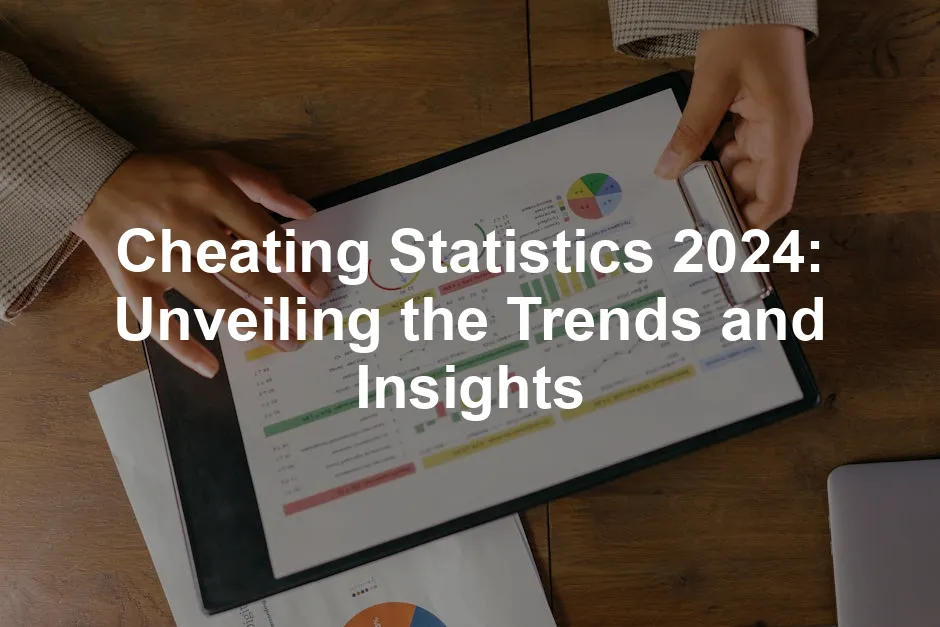Introduction
Infidelity. It’s a word that sends shivers down the spines of the faithful and raises eyebrows at dinner parties. A betrayal that can unravel the very fabric of relationships, infidelity impacts countless lives. But what does it really mean in our society today?
Understanding cheating statistics is crucial. It helps us navigate the murky waters of love, trust, and commitment. These figures can offer a glimpse into the state of relationships, showing us how societal norms evolve. Are we becoming more faithful or less? Are the reasons for infidelity changing?
In this article, we will explore the cheating statistics of 2024. We’ll analyze the latest trends, uncover the reasons behind infidelity, and consider the consequences that follow. By the end, you’ll have a clearer picture of the infidelity landscape and insights to help you reflect on your own relationships.
So grab your favorite snack, sit back, and let’s dive into the world of infidelity. Spoiler alert: it’s more common than you think!

Understanding Infidelity
Definition of Infidelity
Infidelity isn’t just about physical cheating. It’s a complex issue that encompasses emotional betrayal as well. Emotional infidelity can involve deep connections formed outside of a committed relationship, often leading to feelings of neglect or inadequacy in the primary partnership. Physical infidelity, on the other hand, typically refers to sexual encounters outside the relationship.
Culture and personal beliefs play a significant role in how infidelity is defined. For some, a simple flirtation may feel like cheating; for others, it might take a more explicit act. These varying perspectives can complicate conversations around cheating, making it vital to establish clear boundaries within relationships.

Historical Context
Historically, infidelity has been viewed through a lens of stigma and secrecy. The perception of cheating has shifted over the decades. In the past, society often placed the blame squarely on women, while men were given a pass for their indiscretions. Fast forward to today, and we see a more nuanced understanding of infidelity that acknowledges the complexities of human relationships.
Statistics leading up to 2024 reveal a notable trend: women’s infidelity rates have increased by roughly 40% since the 1990s. This shift reflects changing societal norms and increased independence among women. The conversation around infidelity is evolving, and understanding these changes is crucial. Cheating is no longer a male-dominated issue; it’s a shared human experience that can touch anyone, regardless of gender.
As we move forward, keep these definitions and historical shifts in mind. They provide essential context for the statistics you’ll see in the next sections, painting a more comprehensive picture of infidelity in 2024.

Cheating Statistics Overview for 2024
Overall Infidelity Rates
Infidelity is a hot topic that’s hard to ignore. Recent statistics reveal that about 20% of married men and 13% of married women have admitted to cheating. But wait, there’s more! Among younger adults aged 18-29, infidelity rates appear to be creeping up. In this age group, around 11% of women and 10% of men reported having cheated. So, is infidelity becoming a rite of passage for the young? It seems like it!
Digging deeper, we see that demographics play a significant role in these numbers. For instance, adults in their 60s and 70s report some of the highest infidelity rates, with 24% of men and 16% of women admitting to cheating. It turns out that age isn’t a deterrent; it may even be a catalyst! Interestingly, individuals from divorced families tend to cheat more, highlighting the impact of upbringing on relationship behaviors.

To help navigate the complexities of relationships, consider exploring Couples Therapy Workbook for Healing from Infidelity. This resource can provide guidance and exercises to help partners rebuild trust and communication after betrayal.
Gender Disparities in Cheating
The age-old question of who cheats more—men or women—continues to spark debate. Historically, men have been more likely to cheat, but recent trends show that women are catching up. Women’s infidelity rates have surged by 40% over the past two decades. Yes, you read that right!
In 2024, 22% of men compared to 13% of women have admitted to cheating on their partners. Yet, among younger adults, the numbers shift, with more women in the 18-29 age bracket stepping into infidelity. What drives these differences? For men, sexual desire often tops the list of motivations. Women, however, tend to cheat for emotional fulfillment, seeking connections that their partners may not provide. It’s a tale of two motivations!

Infidelity by Age Group
Age plays a crucial role in infidelity rates. As mentioned, young adults have lower cheating rates. But as individuals hit their forties and fifties, the numbers climb. Men aged 60-69 report the highest rates of infidelity at 26%, while women peak in their 50s at 18%. Why do they cheat at these ages? A mix of nostalgia, a desire for excitement, and the realization that life is too short can lead to risky behaviors.
Moreover, long-term relationships often face increased infidelity rates due to boredom or dissatisfaction. When couples have been together for over a decade, the temptation to stray can become more pronounced. After all, who doesn’t crave a little adventure now and then? Understanding these age-related trends is essential for navigating relationships and recognizing potential pitfalls.
In summary, the cheating statistics of 2024 reveal a complex landscape influenced by age, gender, and emotional needs. With evolving social norms and the rise of digital platforms, infidelity continues to challenge traditional relationship dynamics. As we explore these trends further, it’s clear that communication and understanding are key to fostering healthy relationships.

Impact of Dating Apps and Social Media
In the age of swipes and likes, dating apps like Tinder have become a double-edged sword. On one hand, they connect lonely hearts; on the other, they can become gateways to infidelity. Studies show that 18% to 25% of Tinder users are in committed relationships while using the app. That’s right—while some are looking for love, others are just looking for some fun outside their primary partnerships. A survey found that 42% of Tinder users in the U.S. openly admitted to being married or in a relationship. Talk about swiping right on trouble!
Social media platforms also play a significant role. They provide an easy way to reconnect with old flames or meet new people. A simple like or comment can lead to a private message, which can escalate quickly. It’s no surprise that emotional affairs often spark online, as individuals seek validation and connection. With the click of a button, the line between friendship and infidelity can blur dangerously.

Online Affairs and Cybersex
The digital landscape has transformed the way infidelity unfolds. An increasing number of individuals are engaging in emotional and physical affairs online. Recent statistics indicate that 30% of internet users have participated in sexual activities online that could lead to offline encounters. As many as 10% of adults in relationships reported finding partners through sites like Ashley Madison, known for facilitating affairs.
But it’s not just about physical encounters; emotional affairs are on the rise too. Studies reveal that 91.6% of women and 77% of men have admitted to engaging in emotional cheating, often valuing these connections over physical ones. In a world where maintaining anonymity is easier than ever, the temptation to explore relationships outside committed partnerships becomes more enticing.

Consequences of Infidelity
Emotional and Psychological Impact
The fallout from infidelity can be devastating for both partners involved. Betrayal often leads to feelings of inadequacy, anger, and deep emotional pain. Trust, once shattered, can be incredibly tough to rebuild. In fact, studies show that only 31% of marriages survive infidelity. Many couples find themselves navigating a minefield of emotions, ultimately deciding whether to fight for their relationship or call it quits. The emotional scars can linger long after the affair has ended.
For the betrayed partner, feelings of anxiety and depression are common. They might grapple with self-doubt and questioning their worth. The unfaithful partner, too, may struggle with guilt and shame, especially if they still care for their spouse. Healing requires open communication and often the aid of professional counseling, as both partners work to understand their feelings and the underlying issues that led to infidelity.

If you’re looking for a structured way to address the aftermath of infidelity, consider the Couples Communication Cards. These can help partners express their feelings and facilitate meaningful conversations.
Legal and Financial Consequences
Infidelity doesn’t just hurt emotionally; it can also wreak havoc legally and financially. Infidelity is a leading cause of divorce, with 88% of couples citing cheating as a significant factor in their split. The financial fallout can be substantial, too. Alimony, property division, and legal fees can quickly pile up, leaving both partners in a precarious situation.
In some jurisdictions, infidelity can even affect child custody decisions. Courts may consider the actions of the unfaithful partner when determining custody arrangements, especially if the affair impacts the children’s well-being. Moreover, hidden financial infidelity—like secret spending on affairs—can further complicate divorce settlements.
Navigating the consequences of infidelity is challenging, but understanding the emotional and legal implications can help couples make informed decisions about their relationships moving forward.

Healing and Moving Forward
Relationship Recovery Post-Infidelity
Infidelity can turn relationships upside down, but hope remains. Many couples manage to heal and emerge stronger. According to recent statistics, around 70% of marriages attempt to survive infidelity. That’s a solid majority, which suggests recovery is possible!
So, how do couples mend their broken bond? First, communication is key. Partners must discuss feelings openly. Addressing the hurt, anger, and confusion can pave the way for understanding. Next, establish boundaries. Rebuilding trust requires clear guidelines about what is acceptable moving forward.
Additionally, patience is essential. Healing takes time, and emotions can run high. Couples should allow each other to express their feelings without judgment. It’s crucial to validate each other’s experiences to foster a supportive environment.
Seeking to rebuild intimacy? Start with small gestures. Simple acts of kindness can reignite the spark. Date nights, heartfelt notes, or shared hobbies can help couples reconnect. And don’t underestimate the power of forgiveness. While it’s easier said than done, forgiving each other is vital for moving forward.

Statistics show that couples who work together through infidelity often report improved satisfaction in their relationships. The act of overcoming such a challenge can strengthen the bond. Remember, healing is a journey, not a destination.
If you’re looking for a comprehensive guide to help navigate this journey, consider reading After the Affair: Healing the Pain and Rebuilding Trust When a Partner Has Been Unfaithful. This book provides valuable insights and strategies for couples seeking to heal.
Seeking Professional Help
Sometimes, couples need a little extra help. This is where professional counseling comes into play. Therapy can provide a safe space for partners to explore their feelings and navigate the complexities of their relationship post-infidelity. A trained therapist can offer valuable tools and strategies to help couples communicate more effectively.
Many resources are available for couples facing these challenges. Organizations like the American Association for Marriage and Family Therapy offer directories to find licensed professionals. Online therapy platforms also provide accessibility, allowing couples to seek help from the comfort of their homes.
Support groups can be beneficial too! They allow individuals to share experiences and learn from each other. Engaging with others who have faced similar struggles can provide comfort and insights.
It’s essential to recognize that seeking help is not a sign of weakness. In fact, it demonstrates a commitment to healing and growth. Whether through therapy or support groups, professional help can be a strong ally in the journey towards recovery.

FAQs
Who cheats more, men or women?
When it comes to infidelity, the age-old question remains: who cheats more, men or women? Recent statistics reveal that approximately 20% of married men and 13% of married women admit to cheating. Surprisingly, rates of female infidelity have surged by about 40% over the past two decades. Among younger adults aged 18 to 29, the numbers are interestingly close, with 11% of women and 10% of men admitting to cheating. This shift suggests that while men still lead in overall cheating, women are increasingly willing to step outside their relationships.
What are the main reasons for infidelity?
So, what drives people to cheat? Emotional dissatisfaction tops the list. Many individuals feel their emotional needs are not being met within their current relationships. A significant number of women cheat to seek emotional connections, while men often chase physical satisfaction. Unmet needs like affection, attention, and validation can lead partners to look elsewhere. Another reason is the thrill of the forbidden. Cheating can be exciting, providing a sense of adventure that some find enticing. Understanding these motivations can shed light on the complexities of modern relationships.
How can relationships recover after cheating?
Recovering from infidelity is no cakewalk, but it’s possible! First, open and honest communication is crucial. Partners need to express their feelings, fears, and expectations without holding back. Setting clear boundaries moving forward is also essential. Couples should establish what is acceptable and what isn’t to rebuild trust. Seeking professional help, such as couples therapy, can provide valuable tools for healing. Additionally, patience is key. Healing takes time, and both partners must be committed to the process. With dedication and mutual effort, many couples find a renewed connection.
What role does technology play in modern infidelity?
In today’s digital age, technology has drastically changed the landscape of infidelity. Dating apps like Tinder make it easy to connect with potential partners, often blurring the lines of commitment. Studies show that 18% to 25% of Tinder users are in serious relationships while swiping away. Social media platforms also contribute, allowing people to reconnect with old flames or meet new interests. Emotional affairs often spark online, where boundaries can be easily crossed. The accessibility of technology means that cheating can happen with just a click, complicating modern relationship dynamics.
What are the legal consequences of infidelity?
Infidelity can have serious legal ramifications, especially in divorce proceedings. Many states consider marital misconduct when determining asset division and alimony. Infidelity often comes into play during custody disputes as well, with courts evaluating how the affair may impact children’s well-being. In some jurisdictions, the unfaithful partner may even face consequences like reduced custody rights. Understanding these legal implications is crucial for anyone navigating the aftermath of infidelity, as it can significantly affect one’s financial and emotional future.
Please let us know what you think about our content by leaving a comment down below!
Thank you for reading till here 🙂
To gain a better understanding of the infidelity landscape, you might find it helpful to read an introduction to statistical learning with Python.
For a deeper dive into understanding infidelity, check out The Truth About Cheating: Why Men Stray and What You Can Do to Prevent It. This book sheds light on the motivations behind cheating and offers practical advice for couples.
All images from Pexels




